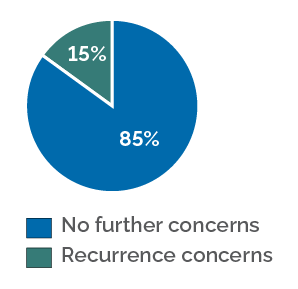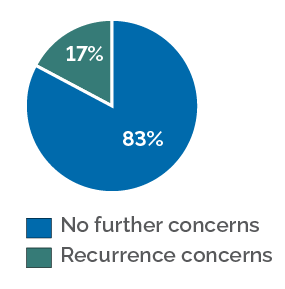Ontario’s Children’s Aid Societies performance indicators - Safety
Overview
When a children's aid society (society), including an Indigenous society, receives information about a child/youth or a family, the society must immediately determine if the situation requires a child protection investigation. Through the investigation process, the society will verify whether there are protection concerns, determine whether a child/youth is in need of protection and identify what services, if any, will be provided to the family. Protection concerns include concerns that a child/youth has been abused or neglected or is at risk of being abused or neglected.
Societies aim to provide families with services as necessary to support them in reducing the need for further involvement from the society. These could include family training, child, youth and/or parent counselling as well as links to community services.
Societies report on two safety performance indicators:
- whether there is a recurrence of child protection concerns in a family after an investigation
- whether there is a recurrence of child protection concerns in a family after ongoing protection services were provided
Importance of these indicators
A primary goal of societies is to keep children and youth safe. Sometimes societies conduct an investigation but no abuse or neglect is verified or, if it is verified, services are provided, after which society involvement ends. However, the family may come into contact with a society again (for the same or different concerns and for the same or different child/youth) and a new investigation may be undertaken that verifies that new concern.
About the data
- The data tracks recurrence of protection concerns by a family's involvement in the child protection system and not by a specific child/youth.
- This information is based on data from 39 societies in 2019-20. The number of societies reporting varies each year depending on a number of factors including data reporting capacity during transitions to CPIN, amalgamations between societies and participation of societies in reporting.
- The number of investigations varies from year to year. This data is based on approximately 26,000 investigations in 2017-18, down from a high of 47,500 investigations in 2012-13.
- The number of families receiving ongoing services varies from year to year. This data is based on approximately 9,000 ongoing protection services that ended in 2017-18, down from a high of 16,000 in 2013-14.
- 26,000Investigations that were conducted in 2017-18 year by societies reporting data
Recurrence of child protection concerns in a family after an investigation
This performance indicator measures the percentage of families investigated for child protection concerns where no protection was necessary and that were reinvestigated within 12 months.
Some families that have previously been investigated by a society experience additional child protection concerns, for the same or for different reasons. Families may also experience changing circumstances and new supports may be required.
The data below shows that, for cases closed after an investigation in 2019-20, 85 per cent of families did not experience a recurrence of child protection concerns. This is consistent with the results of the previous eight fiscal years which have ranged between 84 and 86 per cent.
| Year | No further protection concerns | Recurrence of protection concerns |
|---|---|---|
| 2010-11 | 84% | 16% |
| 2011-12 | 84% | 16% |
| 2012-13 | 85% | 15% |
| 2013-14 | 85% | 15% |
| 2014-15 | 85% | 15% |
| 2015-16 | 86% | 14% |
| 2016-17 | 86% | 14% |
| 2017-18 | 85% | 15% |
| 2018-19 | 84% | 16% |
| 2019-20 | 85% | 15% |
Recurrence of child protection concerns in a family after ongoing protection services were provided
This performance indicator measures the percentage of families that received additional protection services from a society within 12 months following an investigation that originally determined protection services were necessary.
Some families that have previously received services from a society experience additional child protection needs, for the same or for different reasons. Families may also experience changing circumstances and new supports may be required.
The data below shows that, for cases closed in 2019-20 after child protection services were provided, 83 per cent of families did not experience a recurrence of child protection concerns. This is consistent with results over the previous eight fiscal years.
Child protection concerns
after an investigation
(2019-2020 data)

Child protection concerns after ongoing
protection services were provided
(2019-2020 data)

| Year | No further protection concerns | Recurrence of protection concerns |
|---|---|---|
| 2010-11 | 81% | 19% |
| 2011-12 | 81% | 19% |
| 2012-13 | 82% | 18% |
| 2013-14 | 82% | 18% |
| 2014-15 | 81% | 19% |
| 2015-16 | 83% | 17% |
| 2016-17 | 83% | 17% |
| 2017-18 | 83% | 17% |
| 2018-19 | 81% | 19% |
| 2019-20 | 83% | 17% |
Performance indicators by individual societies
The percentage of recurrence of child protection concerns in a family after an investigation
This information shows eight years of data on the rates of recurrence of child protection concerns in a family after an investigation by an individual society.
The percentage of recurrence of child protection concerns in a family after ongoing services were provided
This information shows eight years of data on the rates of recurrence of child protection concerns in a family after ongoing services were provided by an individual society.